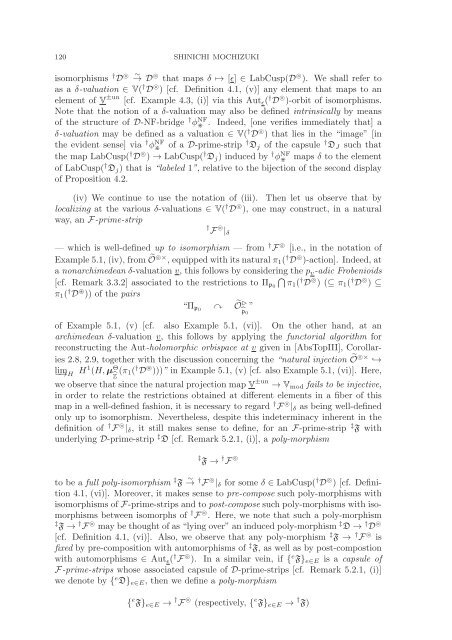Inter-universal Teichmuller Theory I: Construction of Hodge Theaters
Inter-universal Teichmuller Theory I: Construction of Hodge Theaters
Inter-universal Teichmuller Theory I: Construction of Hodge Theaters
Create successful ePaper yourself
Turn your PDF publications into a flip-book with our unique Google optimized e-Paper software.
120 SHINICHI MOCHIZUKI<br />
isomorphisms † D ⊚ →D ∼ ⊚ that maps δ ↦→ [ɛ] ∈ LabCusp(D ⊚ ). We shall refer to<br />
as a δ-valuation ∈ V( † D ⊚ ) [cf. Definition 4.1, (v)] any element that maps to an<br />
element <strong>of</strong> V ±un [cf. Example 4.3, (i)] via this Aut ɛ ( † D ⊚ )-orbit <strong>of</strong> isomorphisms.<br />
Note that the notion <strong>of</strong> a δ-valuation may also be defined intrinsically by means<br />
<strong>of</strong> the structure <strong>of</strong> D-NF-bridge † φ NF<br />
. Indeed, [one verifies immediately that] a<br />
δ-valuation maybedefinedasavaluation∈ V( † D ⊚ ) that lies in the “image” [in<br />
the evident sense] via † φ NF<br />
<strong>of</strong> a D-prime-strip † D j <strong>of</strong> the capsule † D J such that<br />
the map LabCusp( † D ⊚ ) → LabCusp( † D j ) induced by † φ NF<br />
maps δ to the element<br />
<strong>of</strong> LabCusp( † D j )thatis“labeled 1”, relative to the bijection <strong>of</strong> the second display<br />
<strong>of</strong> Proposition 4.2.<br />
(iv) We continue to use the notation <strong>of</strong> (iii). Then let us observe that by<br />
localizing at the various δ-valuations ∈ V( † D ⊚ ), one may construct, in a natural<br />
way, an F-prime-strip<br />
† F ⊚ | δ<br />
— which is well-defined up to isomorphism —from † F ⊚ [i.e., in the notation <strong>of</strong><br />
Example 5.1, (iv), from Õ⊚× , equipped with its natural π 1 ( † D ⊚ )-action]. Indeed, at<br />
a nonarchimedean δ-valuation v, this follows by considering the p v -adic Frobenioids<br />
[cf. Remark 3.3.2] associated to the restrictions to Π p0<br />
⋂<br />
π1 ( † D ⊚ )(⊆ π 1 ( † D ⊚ ) ⊆<br />
π 1 ( † D ⊛ )) <strong>of</strong> the pairs<br />
“Π p0 Õ⊲̂p 0<br />
”<br />
<strong>of</strong> Example 5.1, (v) [cf. also Example 5.1, (vi)]. On the other hand, at an<br />
archimedean δ-valuation v, this follows by applying the functorial algorithm for<br />
reconstructing the Aut-holomorphic orbispace at v given in [AbsTopIII], Corollaries<br />
2.8, 2.9, together with the discussion concerning the “natural injection Õ⊚× ↩→<br />
lim −→H<br />
H1 (H, μ Θ Ẑ (π 1( † D ⊛ )))” in Example 5.1, (v) [cf. also Example 5.1, (vi)]. Here,<br />
we observe that since the natural projection map V ±un → V mod fails to be injective,<br />
in order to relate the restrictions obtained at different elements in a fiber <strong>of</strong> this<br />
map in a well-defined fashion, it is necessary to regard † F ⊚ | δ as being well-defined<br />
only up to isomorphism. Nevertheless, despite this indeterminacy inherent in the<br />
definition <strong>of</strong> † F ⊚ | δ , it still makes sense to define, for an F-prime-strip ‡ F with<br />
underlying D-prime-strip ‡ D [cf. Remark 5.2.1, (i)], a poly-morphism<br />
‡ F → † F ⊚<br />
to be a full poly-isomorphism ‡ F ∼ → † F ⊚ | δ for some δ ∈ LabCusp( † D ⊚ ) [cf. Definition<br />
4.1, (vi)]. Moreover, it makes sense to pre-compose such poly-morphisms with<br />
isomorphisms <strong>of</strong> F-prime-strips and to post-compose such poly-morphisms with isomorphisms<br />
between isomorphs <strong>of</strong> † F ⊚ . Here, we note that such a poly-morphism<br />
‡ F → † F ⊚ may be thought <strong>of</strong> as “lying over” an induced poly-morphism ‡ D → † D ⊚<br />
[cf. Definition 4.1, (vi)]. Also, we observe that any poly-morphism ‡ F → † F ⊚ is<br />
fixed by pre-composition with automorphisms <strong>of</strong> ‡ F, as well as by post-compostion<br />
with automorphisms ∈ Aut ɛ ( † F ⊚ ). In a similar vein, if { e F} e∈E is a capsule <strong>of</strong><br />
F-prime-strips whose associated capsule <strong>of</strong> D-prime-strips [cf. Remark 5.2.1, (i)]<br />
we denote by { e D} e∈E , then we define a poly-morphism<br />
{ e F} e∈E → † F ⊚ (respectively, { e F} e∈E → † F)
















